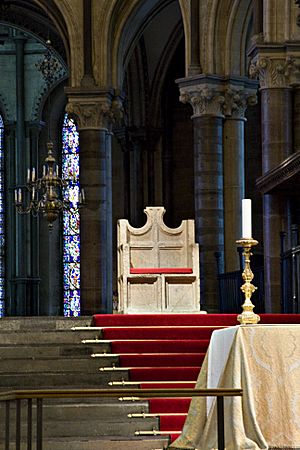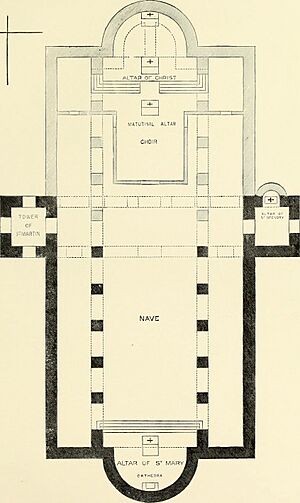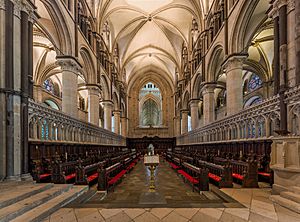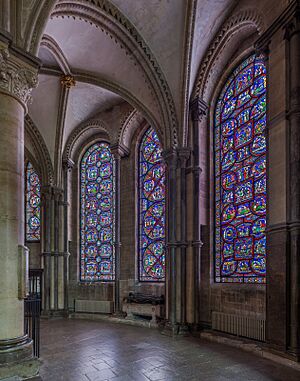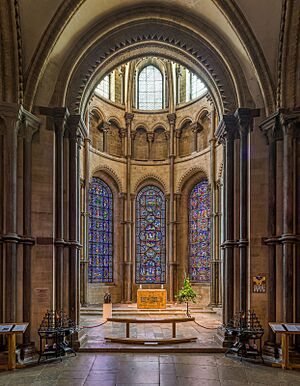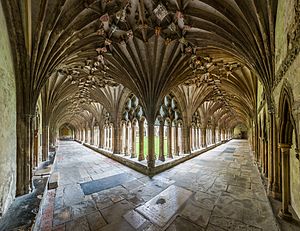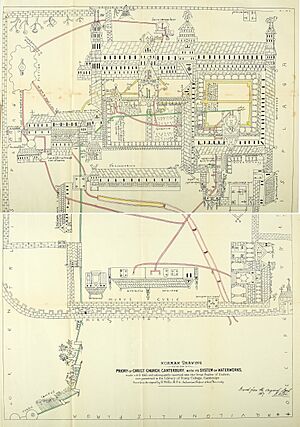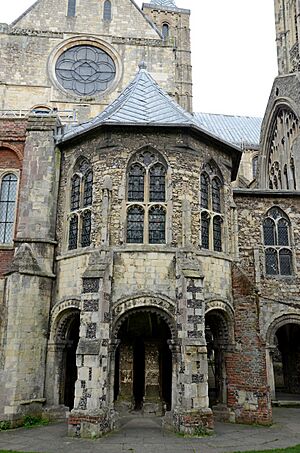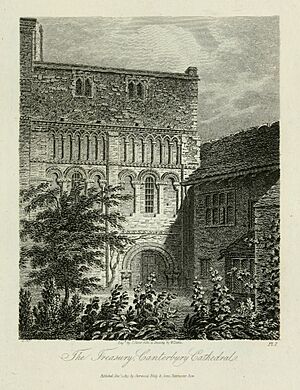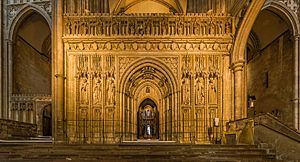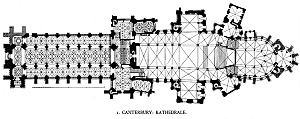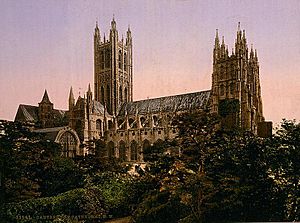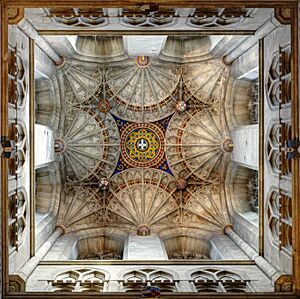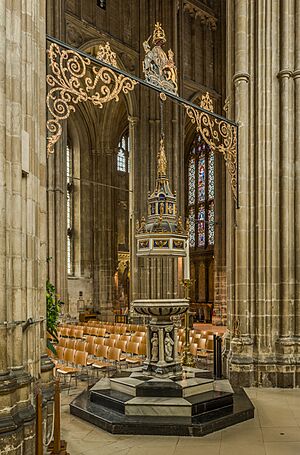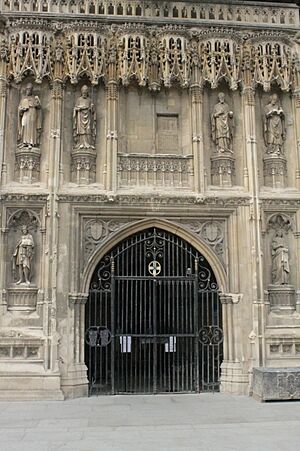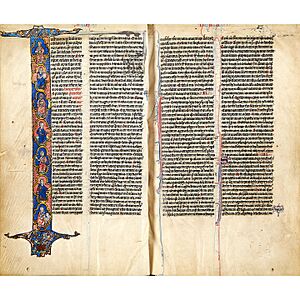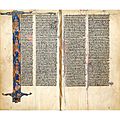Canterbury Cathedral facts for kids
Quick facts for kids Canterbury Cathedral |
|
|---|---|
| Cathedral and Metropolitical Church of Christ, Canterbury | |

Cathedral from the city entrance
|
|
| 51°16′47″N 1°04′59″E / 51.2797°N 1.0831°E | |
| Location | Canterbury, Kent |
| Country | England |
| Denomination | Church of England |
| Previous denomination | Roman Catholicism |
| Churchmanship | Liberal Anglo-Catholic |
| History | |
| Status | Cathedral |
| Consecrated | 1070 |
| Architecture | |
| Functional status | Active |
| Heritage designation | Grade I listed |
| Designated | 3 December 1949 |
| Architectural type | Cruciform basilica |
| Style | Romanesque, Gothic |
| Groundbreaking | 1070 |
| Completed | 1834 (last major alteration) |
| Specifications | |
| Length | 525 ft (160 m) |
| Nave length | 178 ft (54 m) |
| Choir length | 180 ft (55 m) |
| Width | 154 ft (47 m) |
| Nave width | 71 ft (22 m) |
| Nave height | 80 ft (24 m) |
| Choir height | 71 ft (22 m) |
| Number of towers | 5 |
| Tower height | 236 ft (72 m) (crossing) |
| Number of spires | 1 (now lost) |
| Spire height | 190 ft (58 m) (northwest tower, demolished 1705) |
| Bells | 14 (1981) |
| Tenor bell weight | 34-3-4 (1767 kg) |
| Administration | |
| Diocese | Canterbury (since 1072) |
| Province | Canterbury |
Canterbury Cathedral is a very old and important church in Canterbury, England. It is the main church for the Archbishop of Canterbury, who is the leader of the Church of England. This makes the cathedral a very special place for Christians around the world. It is also part of a World Heritage Site, which means it's recognized as important globally.
The cathedral was first built in 597 AD. It was completely rebuilt between 1070 and 1077 after a fire. Later, a big part of it was rebuilt in the Gothic style after another fire in 1174. This was done to make space for many visitors coming to see the shrine of Thomas Becket. He was an archbishop who was sadly killed in the cathedral in 1170.
Before the English Reformation, the cathedral was also a Benedictine monastery. Monks lived and prayed there.
Contents
History of Canterbury Cathedral
Early Beginnings
Christianity was present in Britain as early as 208 AD. In 314 AD, three bishops from Britain attended a church meeting in France. However, after the Romans left Britain, Christian life in the east of the island was interrupted.
In 596 AD, Pope Gregory I sent Augustine of Canterbury to England. Augustine's job was to help the Anglo-Saxons become Christians. In 597 AD, Augustine founded Canterbury Cathedral. He dedicated it to Jesus Christ. When more churches were started in England, Augustine became the first archbishop.
Augustine also started St Augustine's Abbey near the city walls. This abbey became the burial place for many archbishops. The abbey is now part of the same World Heritage Site as the cathedral.
Medieval Times
The first church built by Augustine was probably a Roman church that was reused. Later, in the 9th or 10th century, a larger church was built. It had a square central tower. This church looked similar to St Peter's in Rome.
Around 997 AD, a Benedictine monastery was officially added to the cathedral. This monastery was called Christ Church Priory. King Æthelred the Unready and Queen Emma of Normandy were married at the cathedral in 1002.
The cathedral was badly damaged in 1011 during raids by the Danes. The archbishop, Ælfheah, was taken hostage and killed in 1012. He was the first of five archbishops of Canterbury to be killed.
Norman Rebuilding
In 1067, a year after the Norman Conquest, the cathedral was destroyed by fire. Rebuilding started in 1070 under the first Norman archbishop, Lanfranc. He used stone from France and based the new design on a church in Caen. The new church was shaped like a cross and was dedicated in 1077.
Later, under Archbishop Anselm, the eastern part of the cathedral was made much longer. This work was finished around 1126. The new choir area was like a church on its own, with its own transepts (the arms of the cross shape). It had a large, decorated crypt (underground room).
The inside of the choir was very fancy. One writer said it was amazing for its stained glass windows and marble floors.
Thomas Becket's Murder
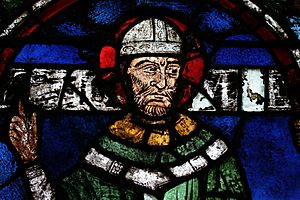
A very important event happened in 1170. Archbishop Thomas Becket was murdered in the cathedral by knights of King Henry II. The king was frustrated with Becket and supposedly asked, "Will no one rid me of this turbulent priest?" Four knights took this seriously and killed Becket.
After his death, many people believed Becket was a saint. The cathedral became a popular place for pilgrims (people who travel for religious reasons). This meant the building needed to be made bigger.
Rebuilding the Choir After Fire
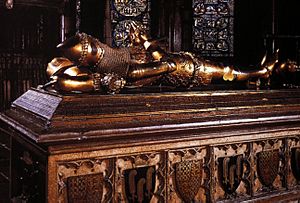
In 1174, the choir area was badly damaged by another fire. This led to a big rebuilding project. The crypt survived, and the outer walls of the choir were kept but made taller. Everything else was rebuilt in the new Gothic style. This style uses pointed arches, ribbed ceilings, and flying buttresses (supports on the outside). The stone came from France. The choir was ready to be used again by 1180.
The main builder for this part was a Frenchman named William of Sens. After he was injured, his assistant, known as William the Englishman, took over.
Trinity Chapel and Becket's Shrine
Between 1180 and 1184, the Trinity Chapel was built. This large chapel was made to hold the shrine of St Thomas Becket. Another round chapel, called "Becket's Crown," was added beyond it. This chapel held more of Becket's relics.
Becket's remains were moved to the new shrine in 1220. The shrine was a beautiful chest covered in gold, silver, and jewels. Many valuable gifts were added to it by kings and princes. The chest was usually hidden by a wooden cover. When pilgrims gathered, the cover would be dramatically lifted.
The money from pilgrims visiting Becket's shrine helped pay for much of the cathedral's rebuilding. However, in 1538, King Henry VIII ordered the shrine to be destroyed. Its treasures were taken away.
Monastic Buildings
A plan from around 1165 shows the cathedral and its monastery buildings. The cloister (a covered walkway) and other monastery buildings were on the north side of the church. There was also a separate chapter-house, which is still there today. It is known as the largest of its kind in England. Its stained glass windows show the history of Canterbury.
The monastery had different areas for monks, guests, and servants. There was an infirmary for sick monks. The monks' common room was called the "calefactory." There was also a large toilet building with 55 seats, designed with good hygiene in mind, with water running through it.
Near the dining hall, there was a kitchen and places for storing food. There were also two places where monks washed their hands before and after meals. One of these is a round, two-story tower called the lavatorium. The treasury, which held valuable items, was near the east end of the cathedral.
Later Medieval Changes
In the early 1300s, a stone screen was built in the choir. The chapter house was also rebuilt.
The cathedral was badly damaged by an earthquake in 1382. It lost its bells and a tower.
From the late 1300s, the nave (the main part of the church) and transepts were rebuilt. This was done in the Perpendicular style. The old pillars were removed and replaced with new Gothic ones. The new nave and transepts had beautiful vaulted ceilings with decorative bosses (carved decorations).
The cloisters were also repaired and remodeled around 1396. The west towers were rebuilt later because of money shortages. The Norman northwest tower was not replaced until 1834.
Around 1430, a chapel dedicated to St Michael was added. A Lady Chapel was built between 1448 and 1455. The tall central tower, called the "Angel Steeple," was started in 1433. It is 235 feet (72 meters) high.
Modern History
Reformation and Civil War
The cathedral stopped being a monastery during the Dissolution of the Monasteries in 1539. It became a church with regular clergy instead of monks. The shrine of St Thomas Becket was destroyed by order of King Henry VIII.
Around 1576, the crypt (underground area) of the cathedral was given to a group of French Protestants called Huguenots. They used it as their church.
During the English Civil War in 1642–1643, Puritan soldiers damaged the cathedral. They destroyed statues and wooden gates. The gates were restored in 1660, and many other repairs began.
Later Additions and Repairs
In 1688, new wooden seats called misericords were added to the choir. Some of these copied older designs.
Most of the statues on the west front of the cathedral were added in the 1860s. There are 53 statues representing important people in the church and royal family. These include archbishops like Augustine of Canterbury and kings and queens like Queen Victoria.
The original towers of the Christchurch Gate were removed in 1803. They were replaced in 1937. A new bronze statue of Christ was added in 1990.
The old Norman northwest tower was taken down in 1834 because it was unsafe. It was replaced with a new tower that looked like the southwest tower. This made the cathedral look more balanced. This was the last major change to the cathedral's structure.
In 1872, a fire destroyed part of the Trinity Chapel roof. Luckily, the stone and inside were not badly damaged, and it was quickly repaired.
During World War II, the cathedral's library was destroyed by bombing. However, the cathedral itself was saved from major bomb damage by local firefighters.
In 1986, a new altar was placed in the northwest transept. This is the exact spot where Thomas Becket was killed. Above it is a metal sculpture showing a cross and two bloody swords. These represent the four knights who killed Becket.
In recent years, women have been ordained as bishops in the cathedral. In 2022, David Monteith became the Dean of the Cathedral. The cathedral is also used for graduations by local universities.
Keeping the Cathedral Safe
Much of the stone at Canterbury Cathedral is old and crumbling. The roofs leak, and many stained glass windows are damaged. Centuries of weather, pollution, and constant use have taken their toll.
One of the biggest challenges is the roof. The cathedral has a huge lead roof. Most of the wooden frame is good, but much of the lead needs to be replaced. Also, concrete around the roof beams needs to be removed and replaced with traditional wood.
Saving the outside stone, especially on the north side, is also important. The cathedral is partly built of Caen stone from France. Experts study which stones need to be fixed or replaced. Special cleaning methods are used to remove harmful chemical deposits. Inside, work is needed on the Trinity Chapel's ceilings and other chapels. The Treasury building, which holds choir practice rooms, also needs improvements.
The oldest colored glass windows are from the late 12th century. Others are as new as the 1957 windows in the south-east transept. Many have been fixed and protected. However, much more work is needed, especially on the round "Oculus" window from the 12th century.
In 2008, a big restoration of the lead roof over the transept was finished. In 2018, the nave's lead roof was replaced. A huge restoration project called "The Canterbury Journey" was planned to finish in 2021. It cost nearly £25 million. This money came from grants and donations. The project included improving the grounds, making it easier for visitors, and restoring the outside of the cathedral.
Cathedral Staff
The cathedral has a staff called the Foundation. The head of the cathedral is the Dean, currently David Monteith. He works with a group of 30 canons. Four of these canons live at the cathedral. The greater chapter, which includes lay (non-clergy) canons, is legally responsible for the cathedral. They also formally elect a new archbishop when needed. However, they can only elect the person chosen by the monarch.
The Foundation also includes the choristers (choir singers), organists, and other staff. The cathedral has over 300 workers and about 800 volunteers.
Money for the Cathedral
Canterbury Cathedral does not get money from the government. It also does not get money from the Church of England. Only the salaries of the dean and two canons are paid by the Church Commissioners. So, the cathedral mostly pays for itself.
It costs about £20,000 every day to keep the cathedral running. To cover these costs, the cathedral relies on money from visitor entry fees. It also earns money from renting property, the Cathedral Shop, and the Cathedral Lodge Hotel.
Fundraising
An appeal called "Save Canterbury Cathedral" was started in 2006. The goal was to raise £50 million to protect and improve the cathedral. By 2014, over £20 million had been raised.
The main part of the fundraising is for fixing the cathedral's structure. Big restoration projects are expected to cost £30 million. These repairs are the most urgent part of the campaign. The appeal raises money both in the UK and internationally. It highlights the cathedral's role as the "mother church" of the Anglican Communion and a World Heritage Site.
Projects funded by the appeal include repairing the roofs, stone carvings, and pinnacles of the central Bell Harry Tower. Work is also done on the Corona Chapel and the Christ Church Gate. Stained glass windows and their stone frames are being conserved. The collection of old books and manuscripts is also being preserved.
There are also plans to fix the cathedral's pipe organ. Renovations to the Choir House have already been finished. Improvements are planned for the library buildings and the cathedral's sound and lighting systems. These will help visitors, including those with disabilities. The appeal also aims to improve the workshop area and stained glass studio. This will help keep important craft skills alive.
Music at the Cathedral
Canterbury Cathedral has had a choir for 1400 years. The cathedral choir has up to 25 boy choristers and 12 adult singers. The boys are aged eight to thirteen and receive scholarships to attend St Edmund's School. They sing in seven services a week.
The Girls' Choir of Canterbury Cathedral started in 2014. They now share singing duties equally with the boys. The girls are aged 12 to 18 and attend local schools.
In 2023, it was announced that the way child choristers are trained would change. They will no longer live at St Edmund's School. This change is part of a plan to make the choir more open and inclusive.
Organ
The organ at Canterbury Cathedral is very large. It has four keyboards and is located in different parts of the church. It was first built in 1886. It has been rebuilt and made bigger several times. The latest work finished in February 2020.
Organists
Many famous musicians have been organists at Canterbury Cathedral. David Flood was the Organist and Master of the Choristers for over 40 years. The current Director of Music is David Newsholme.
Bells of Canterbury Cathedral
The cathedral has 21 bells in three of its five towers.
The South West Tower has the main set of 14 bells. These are used for change ringing, a special English style of bell ringing. All these bells were recast in 1981. The heaviest bell weighs over 34 long tons. Ringers practice on Thursdays.
The North West Tower has the cathedral's clock chimes. The hour is struck on "Great Dunstan," which is the largest bell in Kent. It weighs over 62 long tons. This bell is also swung on Sunday mornings for services.
The oldest bell in the cathedral is "Bell Harry." It hangs in a cage on top of the central tower, which is named after it. This bell was cast in 1635. It is rung at 8 AM and 9 PM every day to announce the opening and closing of the cathedral.
The cathedral also has the bell from HMS Canterbury, a ship from World War I. It hangs near the Buffs Chapel.
Cathedral Library
The cathedral library has about 30,000 old books and pamphlets. It also has about 20,000 newer books. Many of the older books were donated. The library has many books on church history, British history, travel, science, and the anti-slavery movement.
In 2018, the cathedral bought a medieval Bible at an auction for £100,000. This Bible, now called the "Lyghfield Bible," had been at Canterbury before but was removed centuries ago.
Images for kids
See also
 In Spanish: Catedral de Canterbury para niños
In Spanish: Catedral de Canterbury para niños
- Architecture of the medieval cathedrals of England
- Dean of Canterbury
- English Gothic architecture
- List of cathedrals in England
- World Heritage Sites in England


